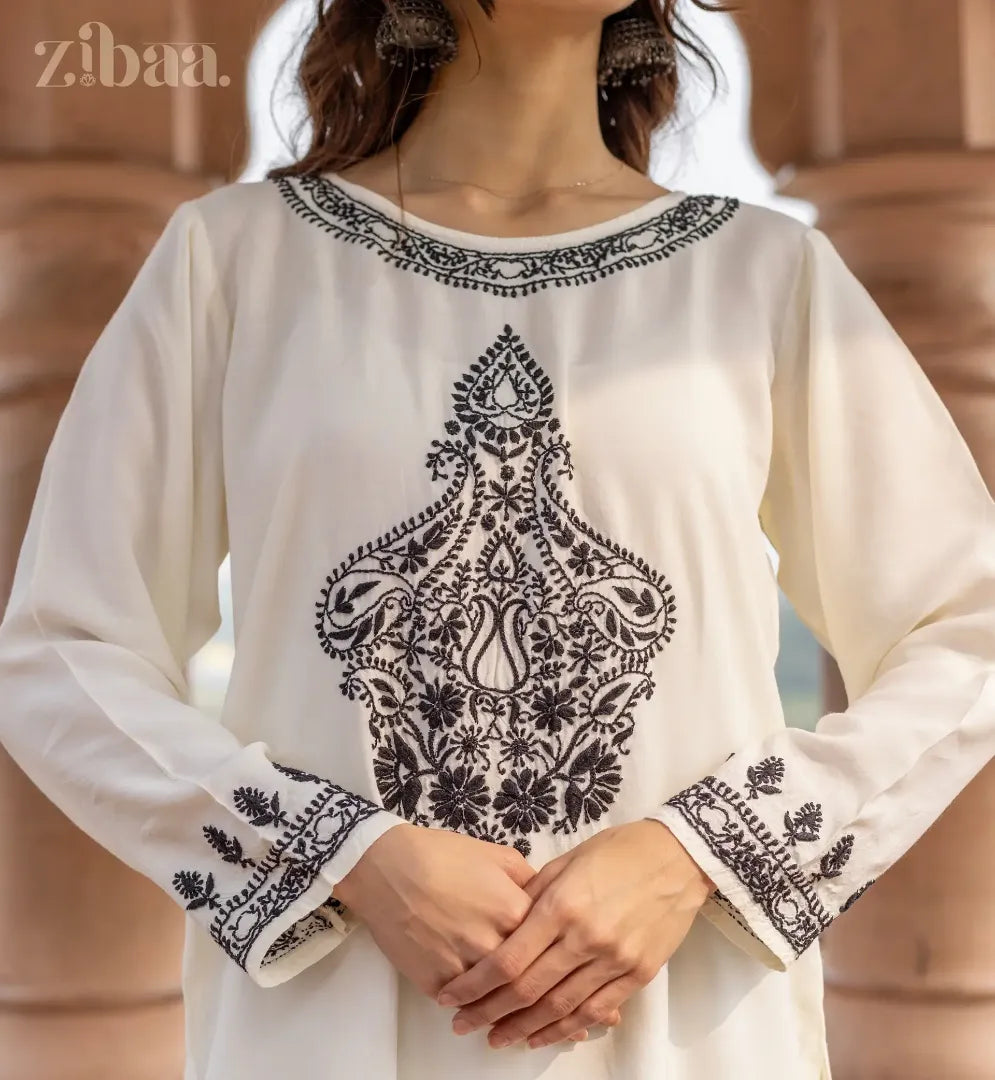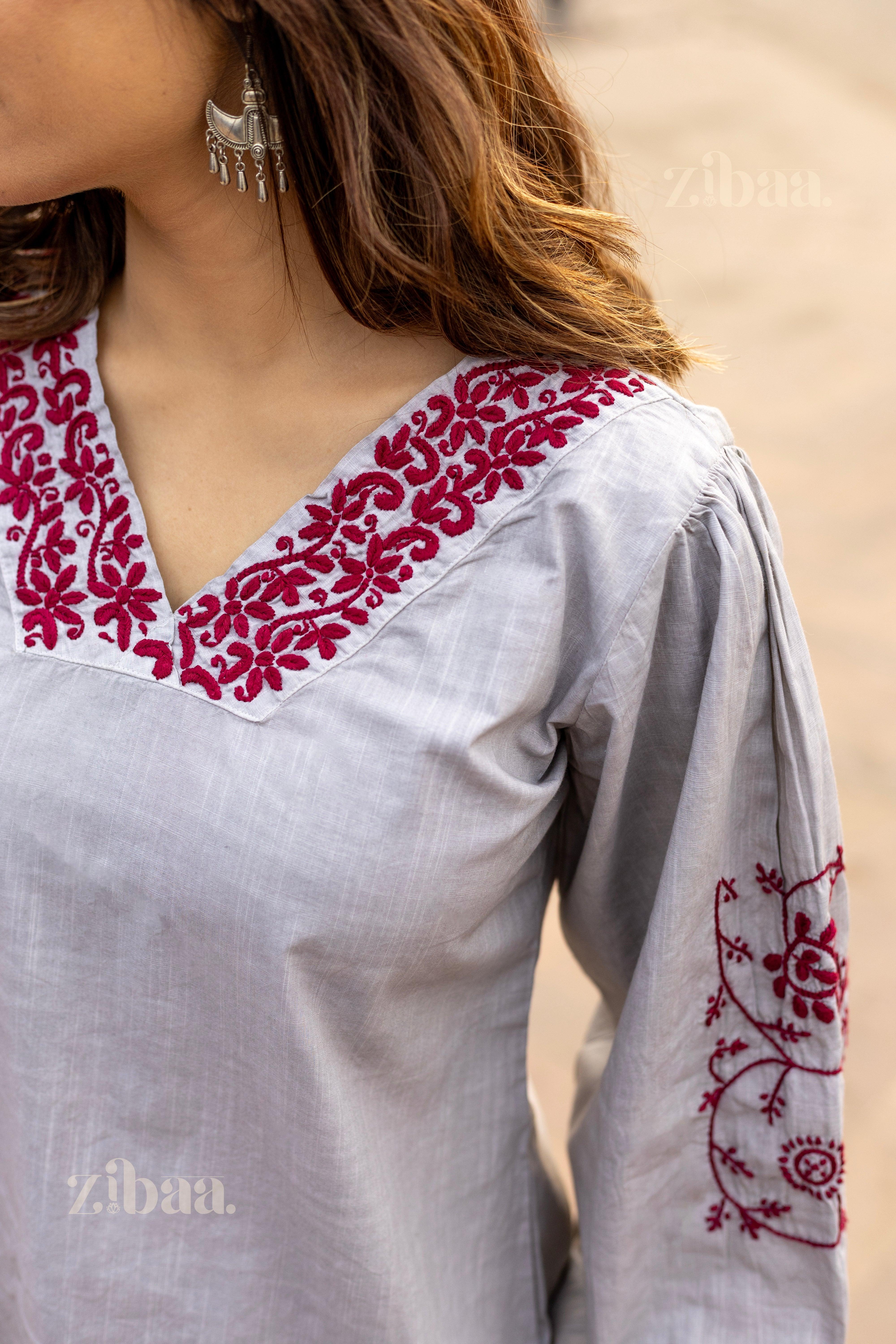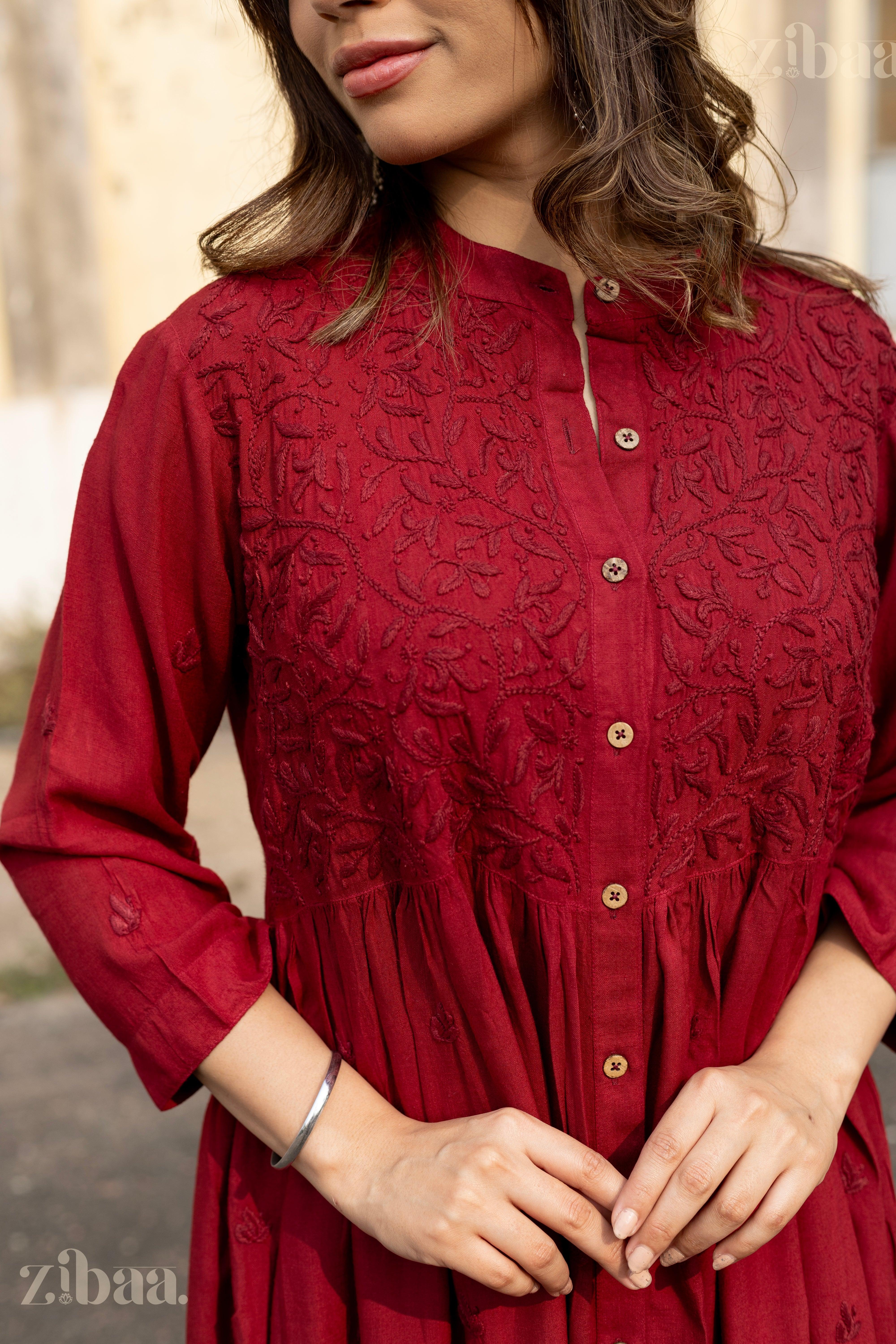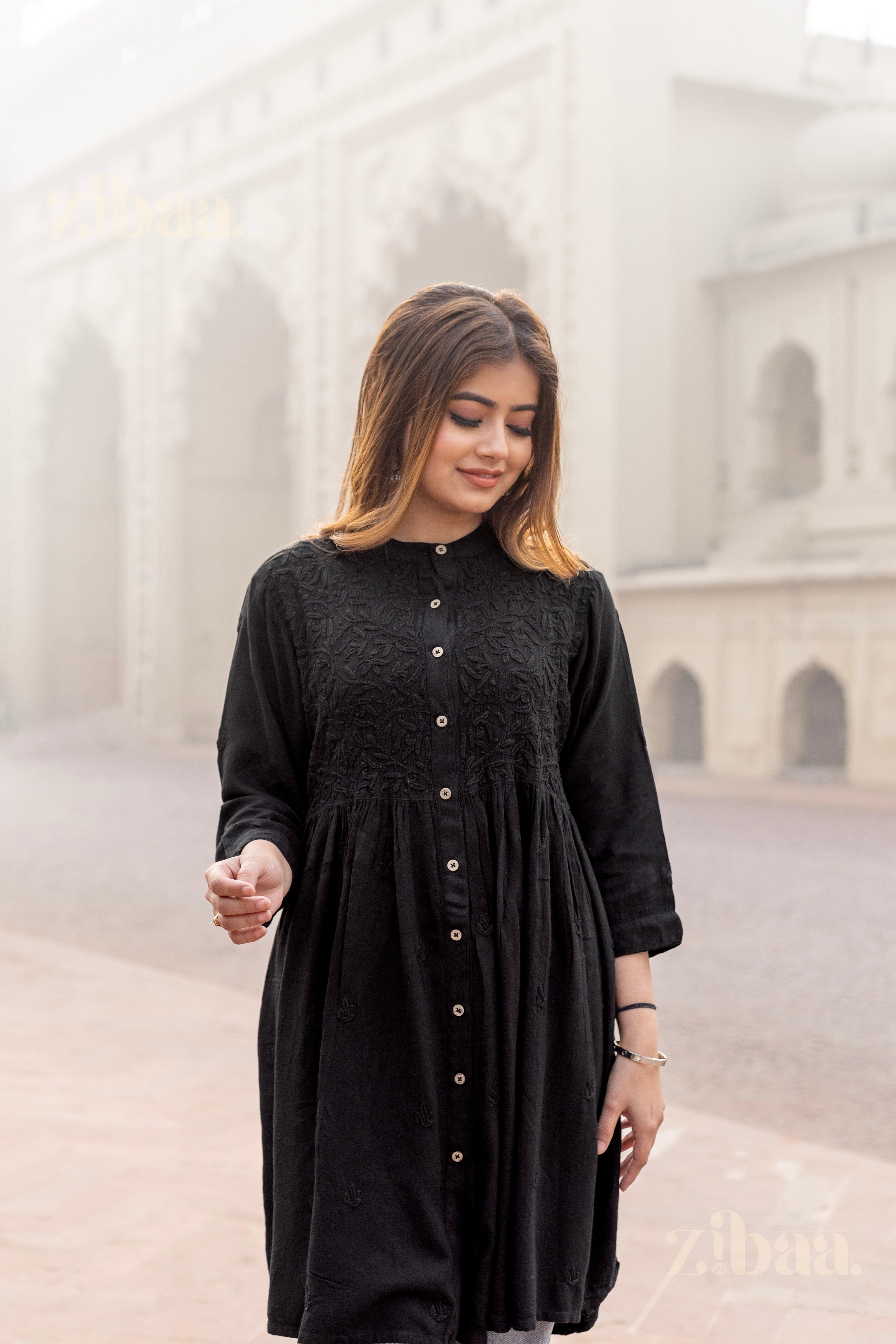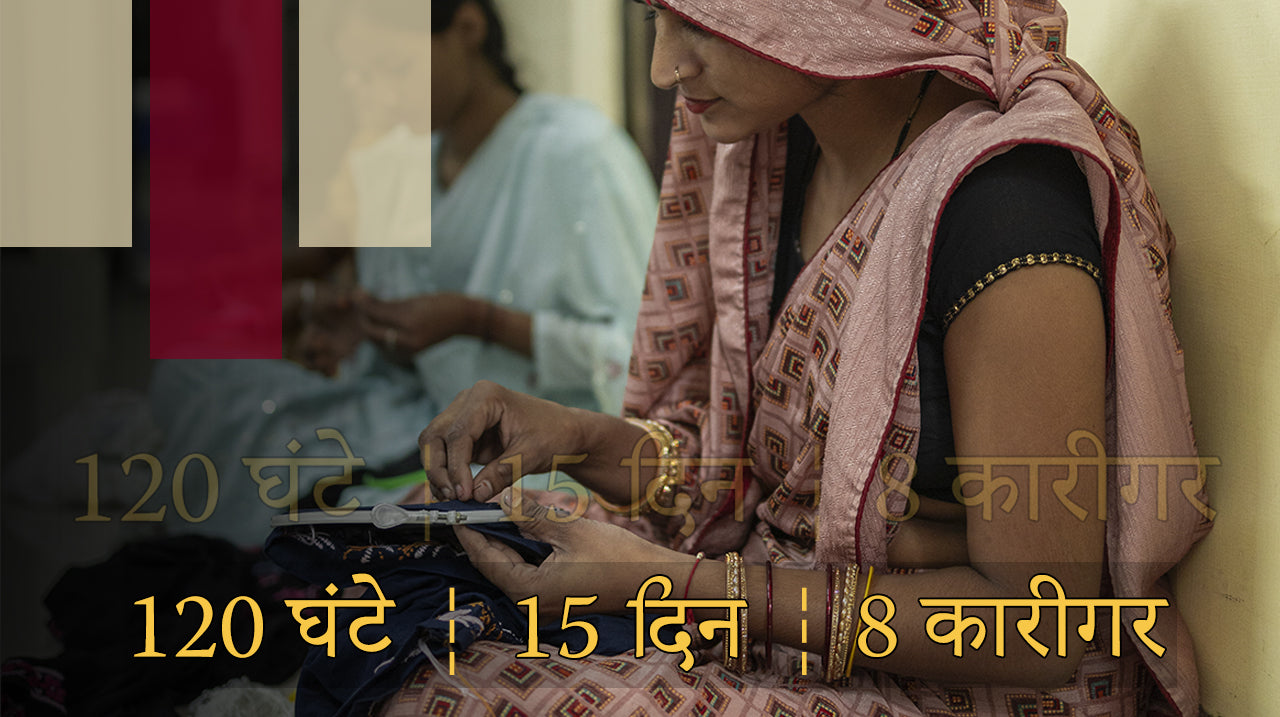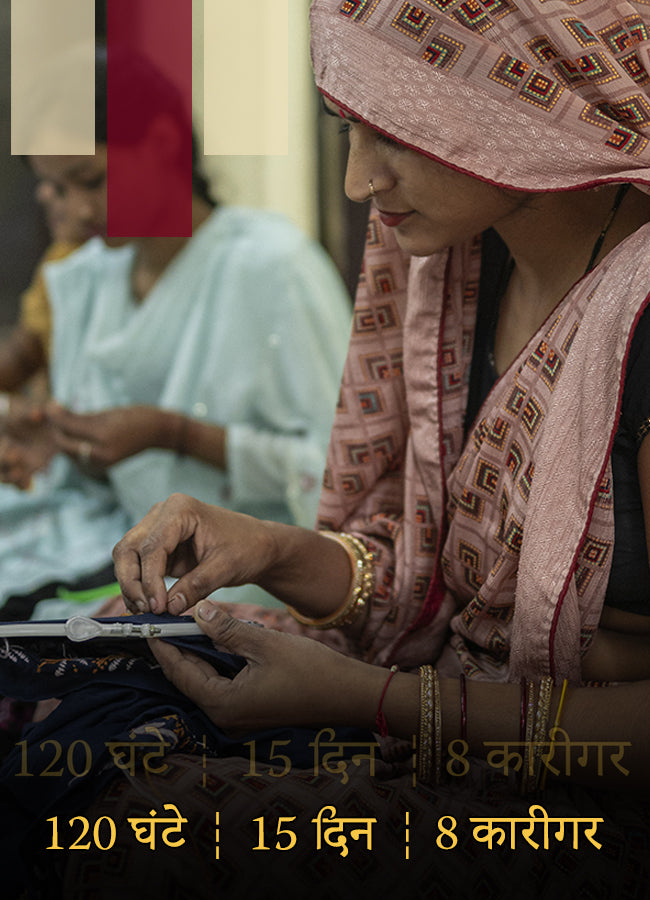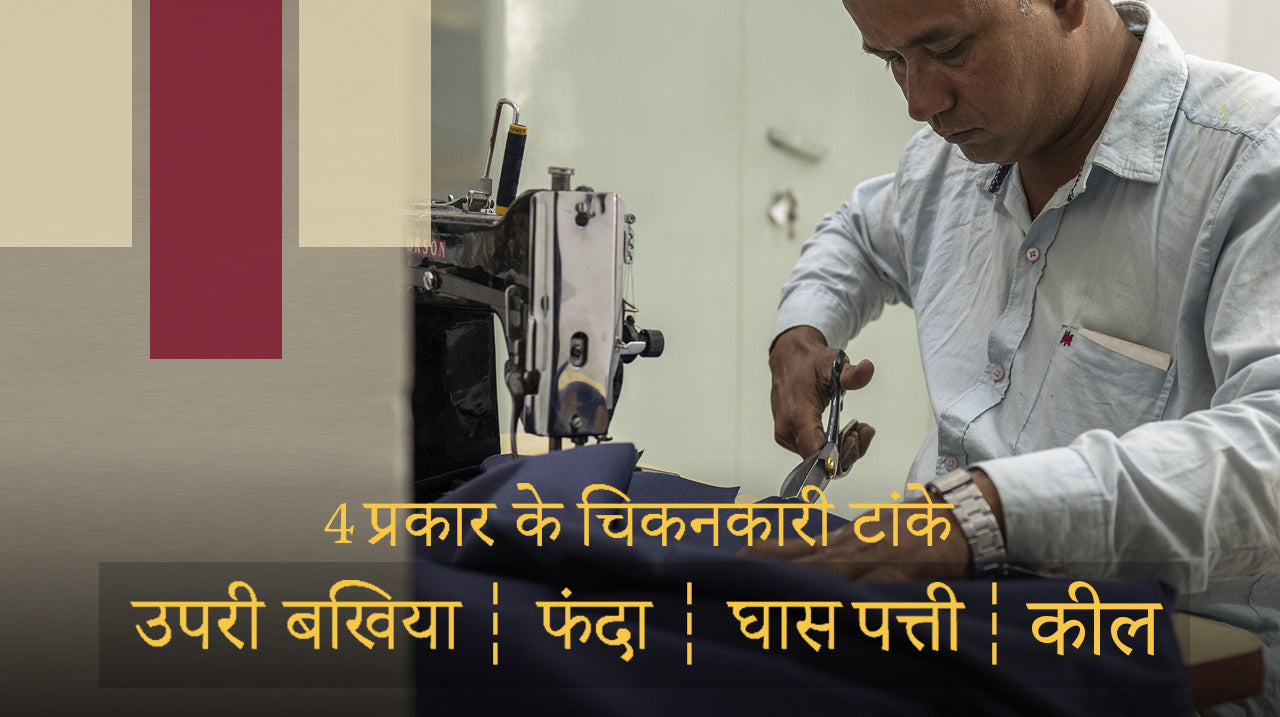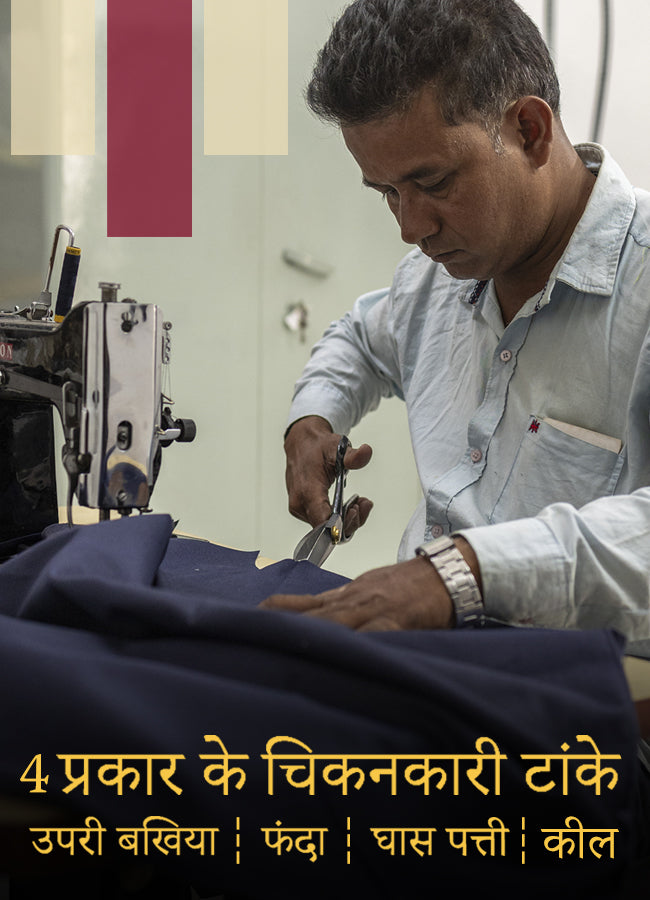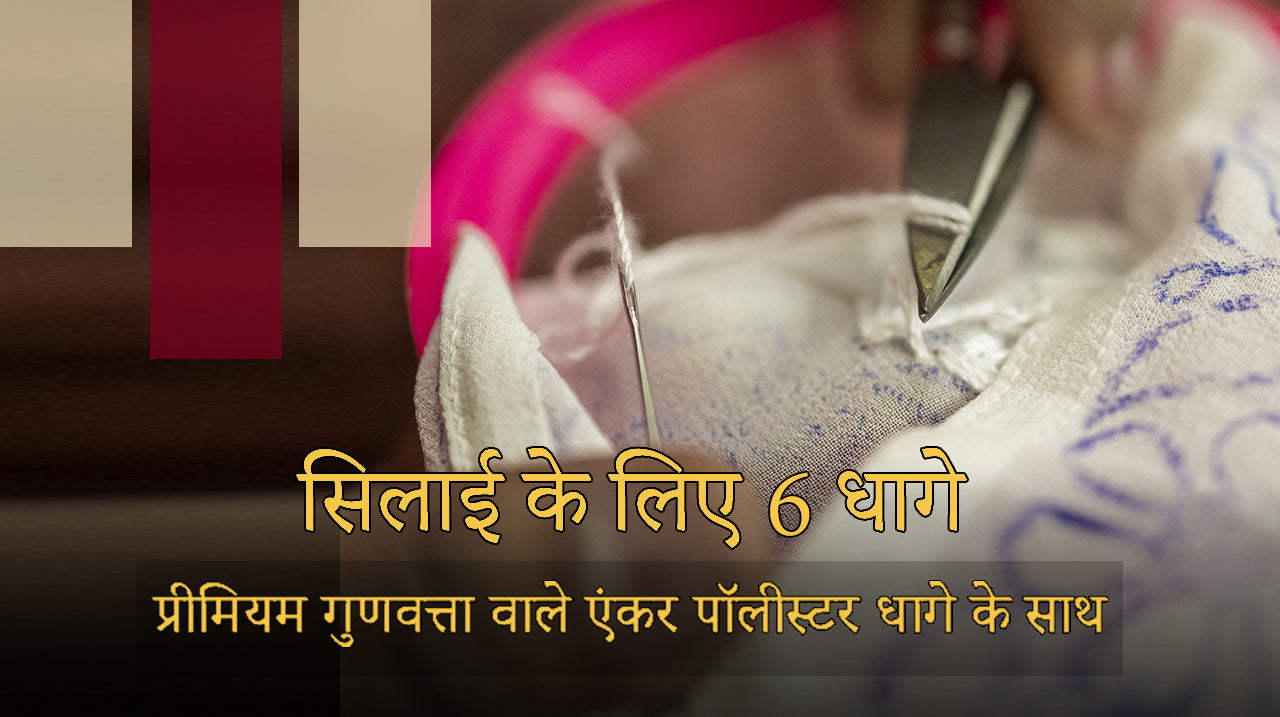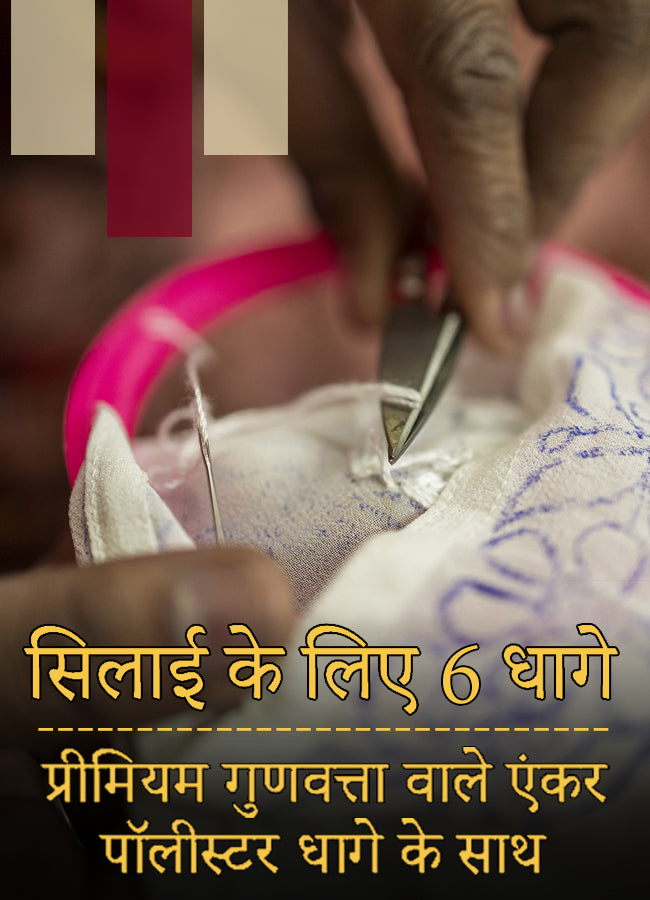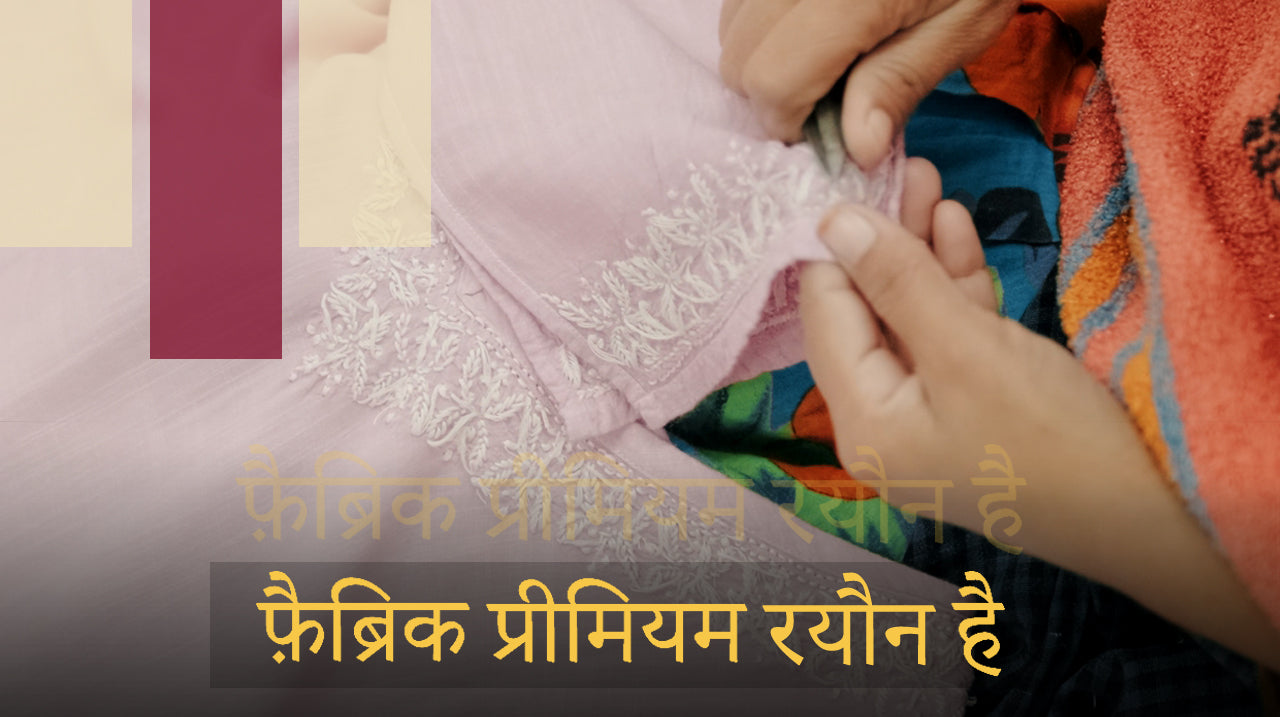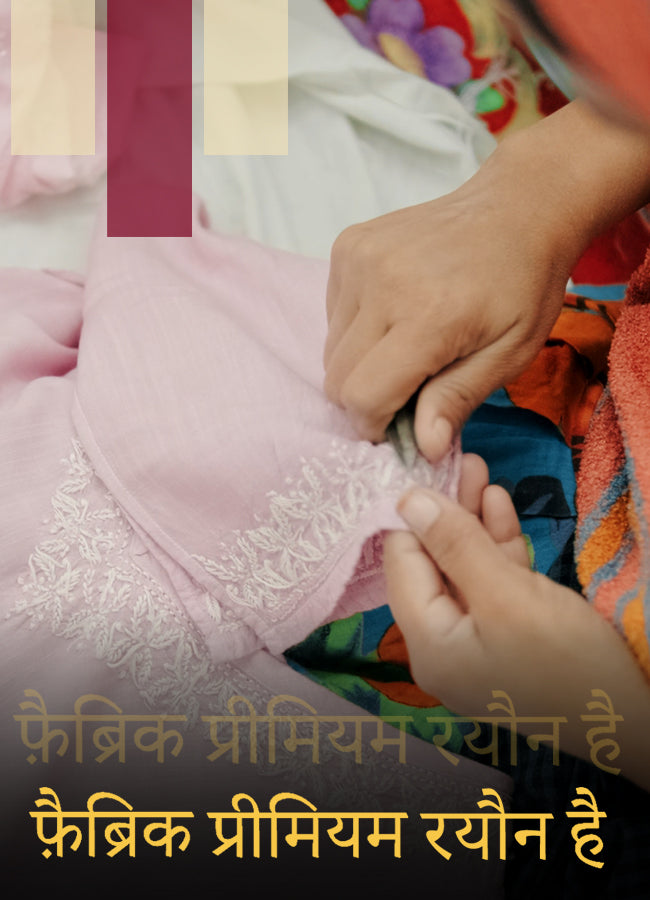Chikankari Tops
The History Behind Lucknow's Delicate Chikankari Embroidery
Chikankari is the delicate and intricate embroidery style that Lucknow is famous for. This beautiful embroidery has been a part of Lucknow's cultural heritage for centuries. The elegant designs and patterns make Chikankari synonymous with Lucknow's grace. It has a long and fascinating history.
Tracing the Origins of an Ornate Art
Chikankari, the delicate and intricate hand embroidery done on fine muslin and cotton fabrics, has a rich history interwoven with legends. As the story goes, this textile art form is said to have originated as early as the 3rd century BC during the reign of the Mauryan Empire in India, when complex craft traditions were exchanged with Persia. The term "Chikankari" itself stems from the Persian word "Chikan" meaning embroidery.
Later, in the 16th century, the art of Chikankari traveled to India again, this time with the Mughals. As admirers and patrons of the arts, the Mughal emperors embraced the delicate beauty of the craft, incorporating Persian and Turkish embroidered motifs and styles.
The Golden Age Under the Nawabs of Awadh
Chikankari embroidery became very popular and peaked during the 18th and 19th centuries. This was the time when the Nawabs of Awadh ruled Lucknow. Nawabs promoted the Chikankari embroidery style in many ways.
The Nawabs brought skilled embroidery artists to their courts and asked the craftsmen to create stunning Chikankari pieces for them. They even added local cultural designs and motifs to the embroidery, making Chikankari reflect Lucknow's unique culture.
Under the Nawabs' patronage, Lucknow became the leading centre for beautiful Chikankari embroidery.
The Evolution of Chikankari - From Royal Art to Global Treasure
-
Originally, Chikankari embroidery was done on white fabric using white thread. This "white on white" style was called "white embroidery".
-
The delicate and beautiful designs were made with intricate stitches inspired by Mughal artwork and motifs.
-
Over time, the Chikankari style developed into an ornate form of embroidery defined by complex patterns and subtle details.
-
Even today, Chikankari remains an integral part of Lucknow's cultural heritage and identity.
-
It is now globally praised for its fine craftsmanship and unique embroidered pieces.
From its origins in royal palaces, Chikankari kurti for women has gained admirers worldwide for its beautiful artistry and captivating legacy.
Reasons for Revenue Growth of Chikankari Art Form in India
The beautiful lucknawi embroidery craft of Chikankari has seen increasing success lately. After some decline, this delicate art has now gained more revenue because of renewed interest and efforts to revive it.
-
Wider Geographic Reach: Earlier, Chikankari was limited to the Lucknow area. But now, its online availability has helped artisans across India learn and adopt it, too. More Chikankari work centres have opened in Delhi, Mumbai, Hyderabad, etc., which has expanded production.
-
Online Retail Boost: E-commerce websites have hugely boosted sales of Chikankari products in India and abroad. Online ethnic brands like Jaypore and Gaatha sell exclusive handmade Chikankari pieces. Big sites like Amazon and Flipkart also feature Chikankari suits and kurtas.
-
Global Access: Websites allow people worldwide to discover and purchase Chikankari kurti for women online. NRIs are a significant segment of Chikankari's online buying. Brand promotion on social media has increased international awareness. Exports to the US, UK, Middle East, etc., have also risen.
-
Government Support: Chikankari received intellectual property rights protection and a geographical indication tag that denoted its unique identity. UP government provides various schemes, new work centres, and skill training to promote local crafts like Chikankari.
-
New Fashion Adaptation: Earlier, it was used only in sarees and salwar suits, but Chikankari is now seen in modern garments like tunics, crop tops, and fusion wear. New designs and colour combinations in contemporary styles attract young buyers.
-
Enhanced Skills: Special Lucknow training centres teach new generations of artisans. The National Institute of Fashion Technology has certificate courses in Chikankari. Workshops organised by export councils have improved designers' skills.
-
Social Media Visibility: Instagram and Facebook pages dedicated to Chikankari display the craft's variety and appeal. Influencers model Chikankari outfits, and celebrities wearing them increase their desirability.
|
Year
|
Revenue (INR Crores)
|
Year-on-Year Growth (%)
|
|
2015
|
200
|
-
|
|
2016
|
250
|
25%
|
|
2017
|
310
|
24%
|
|
2018
|
380
|
23%
|
|
2019
|
470
|
24%
|
|
2020
|
590
|
25%
|
|
2021
|
750
|
27%
|
|
2022
|
950
|
27%
|
|
2023
|
1200
|
26%
|
Chikankari Tops: Embroidery Meets Fashion
When you think "tops", embroidery is probably the last thing that comes to mind. But Chikankari kurti for women are redefining fashion with their unique blend of traditional art and contemporary style.
So, what makes these embroidered tops so unique? Well, Chikankari is no ordinary embroidery. With its delicate stitches and intricate patterns, this traditional craft turns fabric into a canvas for gorgeous floral motifs and geometric shapes. It's the handiwork of skilled craftspeople that makes each piece a work of art.
Modern fashion designers are now taking this ancient embroidery technique and adding their creative touch. The result? Beautifully crafted Chikankari tops that seamlessly fuse heritage and style.
From kurtis to tunics, chikankaii crop top to camisoles, it has come in trendy silhouettes and cuts. But they retain that old-world charm with hand-embroidered patterns embellishing the neckline, sleeves, yoke, or hem. Whether minimalist or dense, the motifs enhance the garment gracefully.
Don't think embroidered tops can't be edgy! Bold and bright colours like crimson, blue chikankari top gives a contemporary twist. Crisp cottons, flowy chiffons, and delicate georgettes drape beautifully when decorated with this needlework.
Match a Chikankari short top with jeans or leggings for an incredible fusion look. When paired with palazzos, Kurtis spells subtle elegance at the workplace or festive gatherings. Tunic tops look super chic with skinny pants or even skirts.
So, next time you go shopping, consider a Chikankari piece. With its fine craftsmanship and sophisticated aesthetic, you'll have a timeless top perfect for any occasion.
Various Forms of Chikankari Tops
Chikankari embroidery has been gracing Indian ethnic wear for centuries. But this ornate needlework is making its way onto all trendy tops today. From kurtis and tunics to crop tops and fusion styles, Chikankari tops come in diverse silhouettes and fabrics.
The Chikankari kurti is a wardrobe staple - elegant, versatile and perfect for any occasion. Crafted from cotton, georgette or chiffon fabrics, these kurtis feature delicate embroidery embellishing the neckline, yoke, sleeves or hemline. Short, straight kurtas look chic with jeans or skirts—Flowy anarkalis spell boho chic styled with palazzos. Opt for minimalist patterns or thick motifs and intricate details.
Chikankari cotton top infuses effortless style into your everyday wear. These short-sleeved tops, with pastel shades and all-over embroidery, are ideal for summer weather. Cotton reflects light beautifully, letting the detailed needlework shine. You can pair these with denim, trousers, or skirts for a comfy and classy fusion look.
Think cool, breathable fabric adorned with ornate patterns. That's the modal Chikankari top for you! Modal is a semi-synthetic fabric derived from plant cellulose with a soft drape and smooth finish. It's the perfect base for showcasing fine embroidery work. These tops make great casual, at-home and loungewear choices.
Sheer, lightweight georgette tops embroidered with Chikankari motifs are an ethnic wear favourite. The delicate base fabric lets the needlework take centerstage while draping gracefully on the body. Choose from sleeveless, short sleeves, or three-fourth sleeves. Pair with palazzos, cigarette pants, or skirts for an elegant Indian look.
Let your inner boho chick rock a Chikankari frock top! These feature whimsical embroidered patterns on frock-style cotton or flowy georgette base. The outline includes a figure-hugging bodice and flared skirt. Style it casually with jeans or shorts, or dress it with wide-legged pants.
Crop tops and Chikankari might seem unlikely, but fashion is all about experimenting! These fun short tops feature embroidery concentrated around the neckline and sleeves. Cropped hemlines let you show off a hint of midriff. Team them with jeans, skirts or monochrome pants.
-
Kaftan Style Chikankari Top
Breezy Chikankari kaftan tops are perfect vacation wear. These oversized button-down tops have relaxed silhouettes with embroidered accents. The vibrant colours and bohemian vibe channel tropical getaway feelings. Layer them over swimsuits or monokinis while lounging by the pool or beach.
Pintucks are slim, rippled folds stitched closely together to make dainty patterns on fabric. Combine these with Chikankari designs, and you have pretty embroidered tops with textured depth. Pintucks add peculiar charm to the yokes, sleeves, collars, or hemlines of cotton, georgette, and voile tops.
Cutwork embroidery involves cutting voids in the fabric and stitching ornamental designs around them. Combined with Chikankari, it creates tops with beautiful shadow work and lace-like patterns. Delicate cutwork and embroidery make a gorgeous statement on georgette, net and chiffon tops.
Whether you prefer ethnic, contemporary, or fusion style, there's a Chikankari top for you. Experiment and find your perfect match from this vast range of embroidered tops.
Stitches Used in Chikankari Tops
|
Stitch Name
|
Description
|
Uses
|
|
Tepchi
|
Tepchi, also known as the running stitch, forms the outline in most motifs and patterns. It comprises basic straight rows of parallel stitches that offer definition and structure in creating any shape with thread.
|
Used to show designs such as vines, grass, flowers, animals, borders, and much more.
|
|
Bakhiya
|
Bakhiya is the most celebrated stitch in Chikankari, known as "shadow work". This stitch is done on the reverse side of the fabric, creating intricate and layered designs that appear on the front. It requires laborious and intricate stitching to achieve a beautiful 3D-like pattern.
|
Used to create lovely 3D-like patterns, and is the most famous feature of Chikankari.
|
|
Hool
|
Hool stitch involves making countless micro knots with precision to create unique circular shapes resembling flower pollen or dew drops. These tiny hole-like stitches create flower or plant designs by sitting together on embroidered leaves and petals.
|
Used to make flower or plant designs, forming beautiful arrangements on leaves and petals.
|
|
Zanzeera
|
Zanzeera, or chain stitch, uses threaded loops linked together. This stitch adds excellent shape and border to the patterns. The crafters use zanzeera creatively not only to outline motifs but also to create intricate designs.
|
Used for outlining motifs and creating detailed designs.
|
|
Murri
|
Murri stitch involves sewing many tiny knots close together to create a three-dimensional effect. This stitch requires great mastery in uniformity and density of application. It often works as the coloured or textured cores of flowers and leaves within motifs.
|
Used to create textured cores of flowers and leaves, adding lighting and surface texture effects.
|
|
Phanda
|
Phanda stitch is made by sewing tiny cross stitches in rows. It works together with murri stitch to add decorations to motifs by creating little spots of difference in colour or texture. Clustered phanda stitches can depict leaves, flowers, plants, etc.
|
Used for creating embellishing designs within bigger patterns, adding decorative details.
|
|
Jali
|
Jali stitch involves separating the fine muslin or cotton threads carefully to form a net-like pattern. This lace-like jaali creates dreamy designs and contrasts with simpler motifs, adding lightness and sophistication to patterns.
|
Used to create net-like patterns, adding a light and sophisticated look to the designs.
|
|
Katao
|
Katao stitch is a cutwork technique where the fabric is cut and neatly sewn along the cut edges with a slight overlap. This stitch creates grand designs, often used for framing central motifs or fully covering saree borders. It represents specialised talent within the embroidery craft group.
|
Used for creating grand designs, framing central motifs, and covering saree borders, showcasing talent.
|
Fabrics That Bring Out the Grace of Chikankari
Chikankari embroidery involves turning fabric into a canvas for artistic designs crafted with delicate stitches. However, the base fabric plays an equally important role in highlighting the beauty of this needlework. Choosing a suitable textile is key to creating stunning Chikankari tops.
Cotton - A Versatile Canvas
Cotton is perfect for casual and dressy Chikankari tops from Khaddar to Mulmul. The soft, breathable fabric provides a great base to showcase ornate embroidery. Cotton reflects light beautifully to add sheen to the designs. It comes in various weaves and weights suitable for all seasons.
Georgette - Sheer Elegance
Georgette is a great fabric for Chikankari tops. The sheer, lightweight georgette lets the beautiful embroidery designs shine through. Georgette gives a dreamy, romantic look to the tops. Dense embroidered patterns look sophisticated on georgette, while sparse designs have a subtle charm. The delicate sheer fabric complements the artwork and drapes gracefully.
Silk - For Special Occasions
Silk, in crepe, chiffon, or organza weaves, creates a luxurious base for special occasion Chikankari tops. The fabric lends a soft, fluid drape and a wealthy sheen. Intricate bird, floral, and foliage motifs pop in silk's luminous texture. Chikankari combined with zari work on silk spells grandeur.
Chanderi - Timeless Elegance
Handloom chanderi cotton is an excellent fabric for Chikankari embroidery. The sheer, lightweight chanderi shows off the embroidery designs beautifully. Its see-through look lets the patterns shine through in a flattering way as the fabric drapes around the body. Chanderi paired with Chikankari embroidery kurti and wide pants or ghararas create a graceful ethnic look that is timeless.
Kota - Cool and Comfortable
Intricately woven using a unique technique, Kota's checked motifs and airy feel make it ideal for casual summery Chikankari tops. The open weave reflects embroidery clearly while feeling incredible against the skin. Kota cotton paired with minimalist Chikankari patterns oozes effortless charm.
No matter your style or the season, there's a fabric waiting to be transformed into an embroidered masterpiece. Experiment and find the perfect textile match for making your Chikankari tops shine.
Must-Have Colors for Chikankari Tops This Summer
Summer is here, and it's time to break out the breezy dresses, flowy tops and light fabrics. When it comes to Chikankari embroidery, white on white is eternal. But the fun is in experimenting with cheerful colours to embrace the season. Vibrant Chikankari tops in trendy hues can spruce up your summer style.
The little black chikankari top is a wardrobe hero for its versatility. A black Chikankari tunic or kurta paired with white pants, palazzos, or denim makes a sublime combination. Black makes floral, foliage and other motifs pop beautifully. Embellished black tops create an elegant tone-on-tone effect. Sophisticated at work and charming at weddings, black Chikankari top are perfect all-rounders.
From maroon to crimson-red, Chikankari tops spell grandeur like no other. They make bold ethnic wear statements for festivals, weddings, and traditional events. Red is an auspicious colour in Indian culture. Pair embroidered red with contrasting dupattas and bottoms for traditional Indian elegance. Red Chikankari tops also blend well with Western bottoms like jeans.
-
Channel Boho Chic in Yellow
Bright, citrusy yellow Chikankari top or kurti infuse summery boho-chic vibes into any outfit. These cheerful tops look pleasant with white palazzos or pants. Delicate floral Chikankari patterns on mustard and lemon yellow tops make them perfect vacation companions. Yellow chikankari top reflects expressive joy!
This summer, make a glam statement with metallic Chikankari tops in gold, silver, copper, and bronze. Pair them with monochrome pants or skirts for evening soirées and pre-wedding events like mehendi. Delicate work on shimmery fabrics spells tasteful bling and metallic tops glint gorgeously when you hit the dance floor.
Powder blue chikankari top, blush pink, mint green, and more soft pastels lend their breezy charm to Chikankari tops. Floral embroidery on soothing pastels looks romantic and feminine. Pastel tops work for both Western and ethnic looks. For a dreamy vibe, you can rock them on casual days, brunch dates, or summer parties.
Elevated Ethnic: 5 Ways to Style Chikankari Tops
Chikankari kurti and tunics make for elegant Indian wear on their own. But experimenting with different styles can take your embroidered top from basic to chic! Here are 5 fresh ways to elevate your look with Chikankari tops:
-
Fusion with Jeans
Pair your tunic with jeans for a casual spin. Opt for a cigarette fit or straight-leg jeans in a dark wash for a slimming effect. Add some fun ballet flats or kolhapuris to complete the desi meets western vibe. This effortless style works great for college, brunch dates, or hanging out with friends.
-
Traditional Grace with Lehenga
Team your Chikankari top with a lehenga skirt and dupatta for a traditional ensemble. Stick to light fabrics like chiffon or georgette for the lehenga. The flowy skirt with delicate embroidery on top creates an ethereal elegance. Style your hair in soft curls or waves and accessorise with jhumkas. Perfect for weddings and festive occasions!
-
Sophisticated with Palazzos
Palazzos effortlessly complement the grace of Chikankari tops. Opt for solid-coloured palazzos that allow the needlework to take centerstage. Flowy palazzos in silk or chiffon fabric will give a luxurious vibe. Add some stacked bangles, hoops, and a potli bag for a sophisticated look.
-
Boho Chic with Harem Pants
Wide-legged harem pants lend a relaxed vibe, perfect for boho-embroidered tunics or chikankari short top. Choose harem pants in breathable fabrics like rayon or linen. The billowy silhouette offsets fitted Chikankari crop tops. Complete your boho-chic look with juttis and tassel earrings.
-
Formal Style with Sharara
Shararas infuse grandeur into formal ethnic looks. Pair your Chikankari kurta with shararas, broad legs, and ornate leg cuffs. Contrast the kurta colours with sharara hues for a playful outfit. Statement earrings and pumps add polish. This ensemble is ideal for festivals, mehendi, and receptions.
Bollywood Stars Shine in Chikankari Tops
Bollywood leading ladies have been dazzling in beautiful Chikankari tops for decades. From vintage classics to contemporary styles, B-town heroines have flaunted this Lucknavi craft in iconic films.
In classics like Mughal-E-Azam and Pakeezah, actresses wore ornate Chikankari tops in scenes showcasing royal luxury. Meena Kumari looked ethereal in full-sleeved, high-neck embroidered kurtas, while Madhubala shone in elaborate Anarkali-style Chikankari suits. The graceful profiles complemented the delicate needlework.
For celebration scenes in movies like Hum Dil De Chuke Sanam and Devdas, stars opted for festive Chikankari kurti. Aishwarya Rai looked radiant in a red, round-neck short kurta in Dola Re Dola, while Madhuri Dixit swayed in a green embroidered long Anarkali. The colourful, embellished designs reflected a joyous mood.
In contemporary films, leading ladies have rocked trendy cropped Chikankari tops with jeans or skirts for a fusion look. Alia Bhatt looked chic in a pink embroidered chikankari crop top paired with a denim skirt in Student of the Year. Anushka Sharma pulled off a breezy peach embroidered crop top with skinny jeans in Band Baaja Baaraat. Sonam Kapoor rocked a black embroidered short kurta with white cigarette pants in Aisha.
In period dramas, actresses wear long Anarkalis and flowing kurtas decorated with fancy Chikankari embroidery, which shows the royal splendour of the past. Deepika Padukone looked stunning in elaborate outfits in Bajirao Mastani, and Aishwarya Rai gracefully wore embroidered kurtas in Jodha Akbar.
Off-screen, celebs often opt for Chikankari kurtas and tunics for appearances, events and airports. At an awards show, Kareena Kapoor Khan looked elegant in a pastel Chikankari suit. Alia Bhatt rocked a black embroidered kurta with white churidars for Ganpati celebrations. The mix of comfort and class makes Chikankari tops a celeb favourite.
Handcrafted Magic vs Machine-Made Production: The Chikankari Top Debate
Chikankari embroidery kurti or dresses can be handcrafted by skilled artisans or made quickly using machines. Both have differences in quality, cost, uniqueness and purpose. Let's understand them better.
Handmade Chikankari Tops
Hand-embroidered chikankari tops showcase exquisite artistry and craftsmanship. The embroidery work uses a variety of delicate stitches that master artisans carefully execute.
-
Special Skills and Designs: Each hand-embroidered Chikankari kurta is unique because the artisan adds their own style to the embroidery. You can see the craftsperson's talent in the exclusive way they outline motifs and use textures or colours. This makes every piece a unique work of art. Machines cannot copy this individuality.
-
Intricate and Delicate Details: The hand embroidery has very delicate detailing that machines cannot match. Fine stitches like jaalis create a net-like effect. Shadow styles called bakhiya give dimension. Tiny knots called murris add texture. All this provides depth and refinement. Machines cannot embroider to such intricate levels.
-
Keeping Traditions Alive: Money from handmade kurtas provides income directly to the craftspeople. This supports training new artisans and keeps the ecosystem of raw materials, collectives, etc. thriving. So, buying handcrafted Chikankari helps sustain the cultural heritage.
-
Gentle on Skin: Handmade garments involve more natural handling of fabrics. This makes them softer and more skin-friendly compared to the stiffness of machine production. Hand-embroidered kurtas are comfortable for all-day wear and last many years with proper care.
Machine Worked Chikankari Kurtas
Machine-made Chikankari embroidery relies on computerised sewing to produce motifs and patterns on a mass scale. The embroidery uses digitised designs and programmed stitch techniques for swift and consistent output. While lacking the finesse of handwork, machine-made Chikankari allows for quicker production of tops with affordable pricing.
-
Wider Affordability: Machines speed up the bulk production of embroidery, lowering costs and making Chikankari more affordable for broader income groups. Handmade crafts are typically very highly-priced.
-
Consistent Quality: Machines provide accuracy and make hundreds of identical pieces. This standardisation is needed for mass manufacturing and indicates consistent benchmarked quality.
-
Durability: Mechanised production uses specialised strong threads and tight stitching for neat finishing. This gives better durability with regular wear and care. The solid construction suits daily ethnic fashion.
-
Always Available: Bulk machine production ensures a steady supply to meet market demand. This can help provide endless variety, even in peak seasons. Large inventories also mean more design, size, and colour options.
Handcrafted Chikankari offers exceptional artistry and cultural sustenance, while machine production makes embroidered kurtas more accessible everyday wear. The choice depends on individual needs and preferences.


